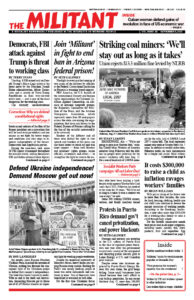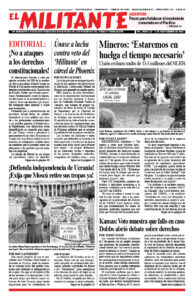Outrage and protests are growing in the U.S. colony of Puerto Rico in the face of repeated power blackouts one year after the government turned over control of the antiquated and decaying public electric grid to Luma Energy, a U.S. and Canadian joint venture.
Despite seven rate increases approved by Puerto Rico’s Energy Bureau this year alone, the grid keeps failing. Some small businesses have closed because they can’t afford to run backup generators. In one recent blackout Aug. 17, more than 230,000 homes and businesses were without power. Luma officials say it was caused by overgrown vegetation.
Along with the blackouts there have been repeated fires at substations and power surges that destroy home appliances.
As calls to cancel the lucrative 15-year government contract increase, even Gov. Pedro Pierluisi — a central architect of the privatization of the grid — has been forced to criticize the company, demanding that Luma change its “execution plan” and “speed up” its work, while continuing to defend the profit-gouging set up.
Over the life of the deal, Luma is to get control of some $10 billion allocated by the Federal Emergency Management Agency to repair damage from Hurricane Maria in 2017 — which left many of the island’s 3 million people without power for a year or more — on top of the $100 million a year it gets for managing the grid. Power generation remains in the hands of the Puerto Rico Electric Power Authority.
The whole electrical system in Puerto Rico has been on the verge of ruin for decades, a byproduct of the plunder of the island’s labor and natural resources by the U.S. colonial rulers.
From 1996 to 2015, the government sold billions of dollars in bonds — mostly to U.S.-based capitalists — then laid off thousands of public workers to make debt payments. The electric utility was particularly hard hit, with the workforce slashed nearly in half. Skilled workers retired early or left for better paying jobs in the U.S. Routine maintenance wasn’t carried out, much less the replacement of obsolete equipment.
When Luma took over, the bosses refused to honor the contract with the UTIER electrical workers union and insisted that each worker reapply to keep working there. Of the 800 linesmen at that time, less than 200 stayed on. “Luma doesn’t even have 350 linesmen now,” UTIER President Ángel Figueroa Jaramillo told the Militant by phone from San Juan Aug. 23. “The problem is their model of privatization, whose aim is to generate profits on the backs of the people of Puerto Rico.”
UTIER is among the organizations demanding the contract with Luma be canceled when its supplementary agreement comes up for renewal in November. In the short term, the linesmen and other workers who have decades of experience with Puerto Rico’s complicated electrical grid need to be brought back to their jobs, Jaramillo said. “In the longer term there needs to be a transformation” in the organization of the public electric system.
“It’s been a disaster,” Mildred Laboy, a retired teacher in Humacao, said by phone. “It’s so bad that even members of the party in power are calling for the contract to be annulled.”
“The outages here in Humacao have been short, but in other towns they often go two or three days without light.” Laboy said that in just a year her electrical bill has increased from $140 a month to $285. “And I don’t have an electrical stove or major electrical appliances.”
Laboy hopes to join a protest in San Juan Aug. 25 demanding the cancellation of the contract with Luma.
In the face of public outrage the company set up a new website that touts its “progress.” One of its achievements: “154 miles of power lines cleared” of overgrown vegetation. But the site makes no mention of the condition of the rest of the more than 18,000 miles of lines across the island.
Meanwhile, another hurricane season is approaching.
Luma has repeatedly ignored requests for comment by the Militant.

